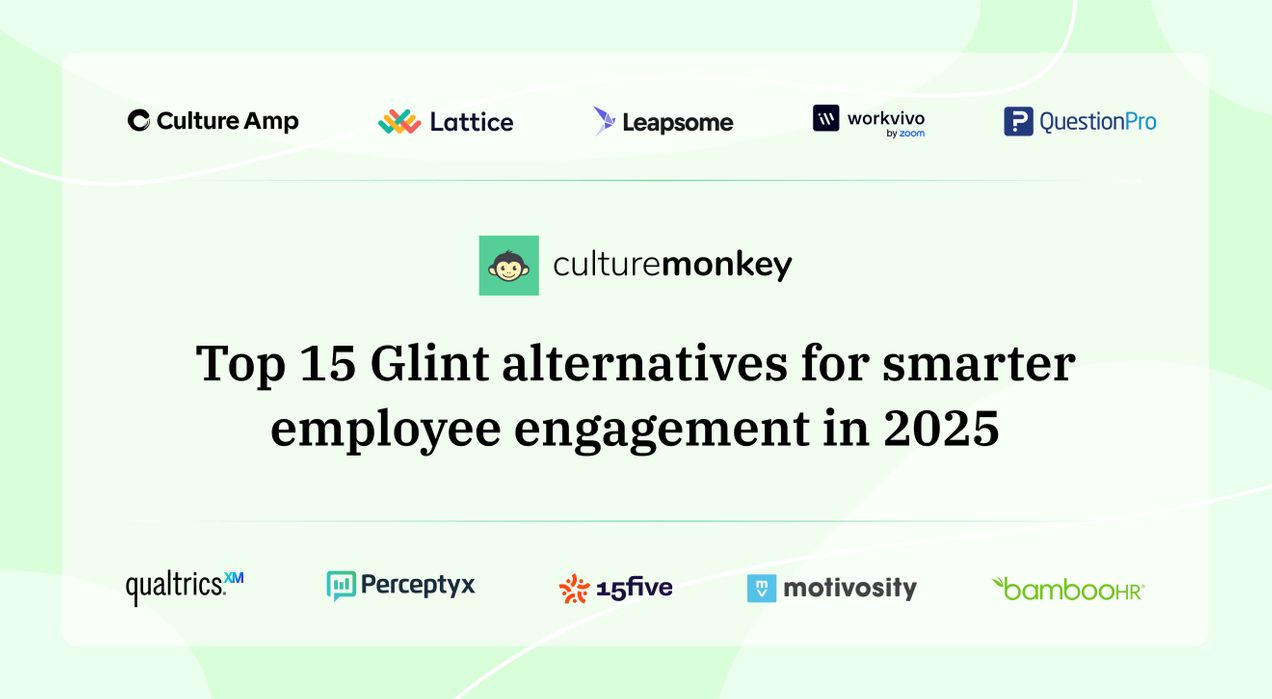Employee engagement in HR: How HR drives satisfaction, productivity, and retention

Remember the thrill of your first school field trip? The bus ride, the snacks, the scribbled permission slip clutched in your hand—pure excitement. Not because the destination was exotic (hello, local museum), but because you felt part of something. Everyone was in it together, sharing the same buzz.
That’s the magic HR hopes to recreate with employee engagement. It's not about flashy perks or one-off events—it’s about cultivating that same sense of inclusion, anticipation, and shared journey.
In this blog, we’ll unpack what real employee engagement looks like and how HR can make every team member feel like they're not just on the bus—but riding shotgun.
Blog Highlights


What is employee engagement's future?

The future of employee engagement is rapidly evolving, driven by shifts in workplace dynamics, advancing technology, and rising employee expectations. Personalized engagement strategies that reflect individual needs, career aspirations, and work styles will be crucial. These tailored approaches will increase the relevance, resonance, and long-term impact of employee experience initiatives across diverse teams and roles.
Technology-driven insights, powered by AI and analytics, will enable real-time understanding and agile responses to engagement trends. As hybrid work becomes the norm, strategies must prioritize inclusivity and cohesion across remote and on-site teams.
Well-being will take center stage—mental health support and holistic wellness programs will be vital to sustaining engagement. Aligning daily work with both company missions and personal values will deepen employee purpose. In this evolving landscape, adaptable, data-informed, people-first strategies will define HR success.



We think it’s important for employees to have fun… it drives employee engagement.
Founder
Zappos
What is employee engagement in HR?

Employee engagement in HR measures employees' enthusiasm, commitment, and motivation, playing a critical role in boosting productivity, morale, and organizational performance.
Effective engagement involves fostering strong relationships and trust between employees and their managers. Creating a respectful environment where employees feel valued includes providing a sense of purpose, meaningful work, and recognition for achievements.
Key elements of engagement encompass open communication, job satisfaction, and development opportunities. Open communication encourages employees to share ideas and concerns, enhancing connection and trust. Job satisfaction and career development initiatives ensure employees remain engaged and productive.
HR-driven engagement initiatives create an open, supportive atmosphere that promotes collaboration and growth. By offering development opportunities and fostering a culture of respect and purpose, organizations can drive higher employee engagement, motivation, and overall performance, leading to sustained success.
Why is employee engagement important?

Employee engagement is a cornerstone of organizational success, driving higher productivity, innovation, and retention. Here are several reasons why it holds significant importance:
- Boosts employee productivity: Engaged employees are more motivated and dedicated to their tasks, often exceeding expectations. This leads to increased output, efficiency, and overall organizational success—key outcomes in HR employee engagement strategies.
- Strengthens employer brand: High engagement levels turn employees into brand ambassadors who promote the organization externally. This supports HR initiatives for employee engagement and enhances people engagement across touchpoints.
- Enhances team collaboration: Engaged employees are more inclined to collaborate and communicate effectively, reinforcing the importance of different areas of HR such as culture, development, and internal communication.
- Aligns individual and organizational goals: Engagement ensures alignment between personal goals and company objectives, a critical aspect of HR and employee engagement planning.
- Increases resilience to change: As defined in the staff engagement definition, committed employees adapt well during transitions, showcasing the HR role in employee engagement and the broader human resources employee engagement agenda. HR engagement efforts like these make employee engagement HR more impactful.
Why avoid disengagement?
- Diminished productivity: Disengaged employees often exhibit reduced motivation, leading to lower output and efficiency. This decline can adversely affect team performance and overall organizational goals.
- Increased absenteeism: A lack of engagement frequently results in higher absenteeism rates, as employees may feel less committed to their roles. This absenteeism disrupts the workflow and places additional strain on present staff.
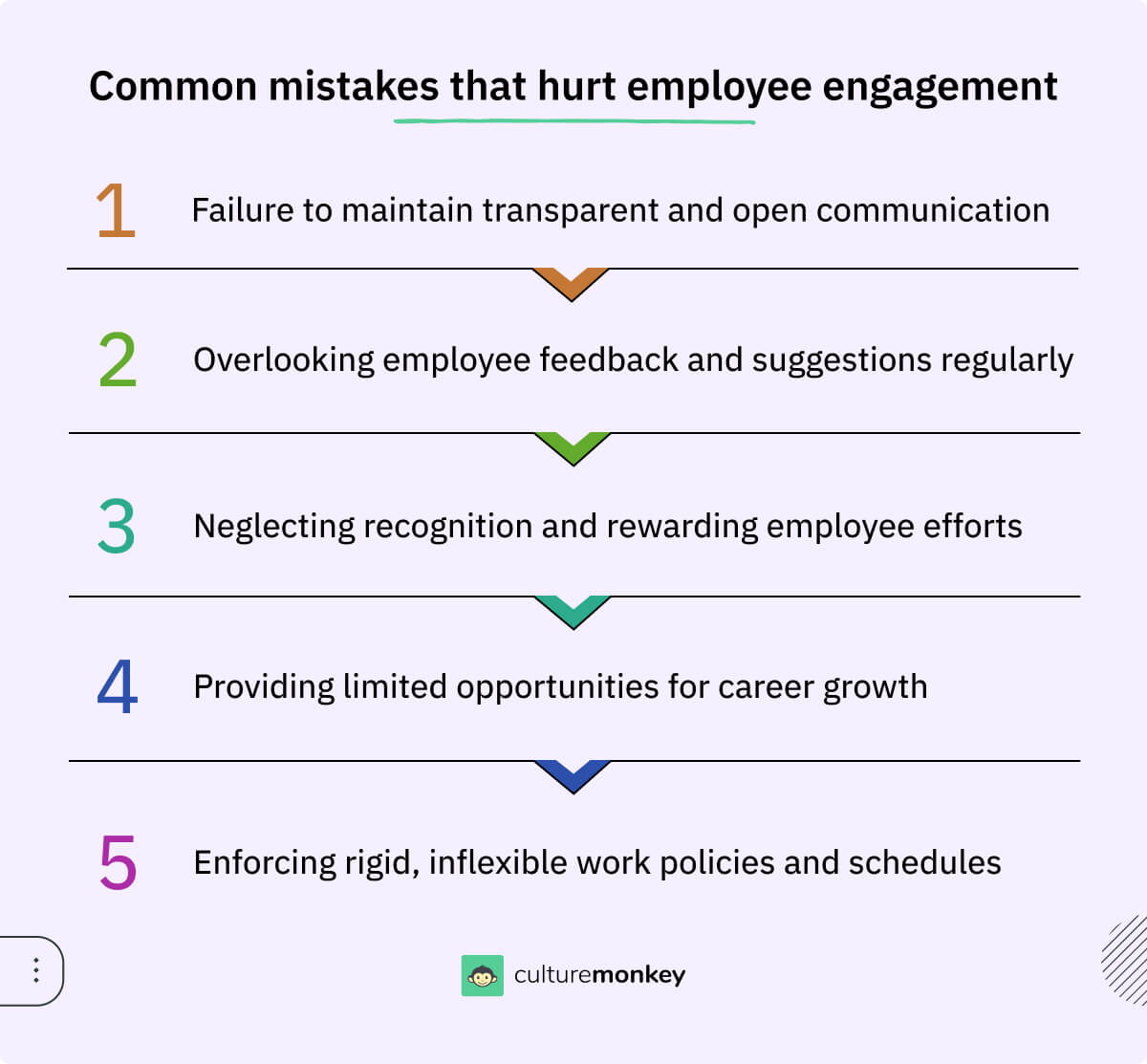
- Elevated turnover rates: Disengaged employees are more likely to seek employment elsewhere, leading to higher turnover. This not only incurs recruitment and training costs but also results in the loss of valuable institutional knowledge.
- Negative workplace culture: Disengagement can foster a toxic work environment, characterized by low morale and poor collaboration. Such a culture can deter potential talent and damage the organization's reputation.
- Customer satisfaction declines: Employees who are not engaged may provide subpar service, directly impacting customer satisfaction and loyalty. This decline can lead to reduced revenue and market share.
- Innovation stagnation: Engaged employees are typically more creative and willing to contribute new ideas. Disengagement stifles innovation, hindering the organization's ability to adapt and grow in a competitive market.
Types of employee engagement in HR

Employee engagement in HR encompasses different types of engagement that shape an individual’s connection to their work, team, and organization. By understanding these distinct engagement types, HR can design tailored strategies to drive overall performance and satisfaction, answering the question: what is employee engagement in HR?
- Emotional engagement: This form involves an employee’s emotional connection to their job, colleagues, and company. It strengthens colleague engagement and contributes to job engagement, creating lasting commitment.
- Cognitive engagement: Reflects how intellectually focused employees are in their roles. It’s key to employee engagement in human resource management, especially in fostering innovation.
- Behavioral engagement: Observable in daily actions—initiative, participation, and collaboration—this signals the success of human resources engagement and effective employee engagement HR policies.
- Social engagement: Encourages strong peer relationships and internal engagement, crucial for a cohesive culture and supportive environment.
- Transactional engagement: Driven by rewards and job security, it's a focus area in employee engagement in HRM but must be balanced with purpose.
- Cultural engagement: When values align, human resources and employee engagement thrive, supporting strategic employee engagement in HR. This illustrates how HR can improve employee engagement holistically.
What are the levels of employee engagement?
Understanding the varying levels of employee engagement is crucial for organizations aiming to enhance workforce productivity and satisfaction. These levels reflect the degree of an employee's emotional and professional commitment to their role and the organization.
- Highly engaged employees: These individuals exhibit a profound connection to their work and the organization's objectives. They consistently demonstrate enthusiasm, proactively contribute ideas, and often exceed performance expectations. Their dedication serves as a catalyst for team motivation and organizational success.
- Moderately engaged employees: Employees at this level perform their duties competently and meet established standards. While they may not display the same fervor as highly engaged employees, they are reliable and contribute positively to the workplace environment. Opportunities for growth and recognition can elevate their engagement.
- Disengaged employees: This group shows minimal interest in their tasks and the organization's goals. Their lack of motivation can lead to decreased productivity and may negatively influence colleagues. Addressing their concerns through targeted interventions is essential to prevent further decline in morale.
- Actively disengaged employees: These employees not only disengage from their responsibilities but may also express dissatisfaction openly, potentially undermining team cohesion and morale. Their behavior can be detrimental to the organizational culture, necessitating prompt and strategic management responses.
Types of HR strategies
HR strategies are the blueprint for aligning people management with organizational goals. Here are six key types of HR strategies that drive business success and employee engagement:
- Talent acquisition strategy: Focused on attracting, hiring, and onboarding top talent, this strategy ensures the organization has the right people in the right roles. It includes employer branding, sourcing channels, diversity hiring, and leveraging data-driven recruitment tools to streamline the process and build a future-ready workforce.
- Learning and development (L&D) strategy: This strategy promotes continuous employee growth through training programs, upskilling, mentorship, and career pathing. A strong L&D strategy supports retention, boosts morale, and is vital for fostering employee engagement in human resource management by showing investment in employees' long-term success.
- Employee engagement strategy: Central to the HR role in employee engagement, this strategy involves initiatives that improve morale, satisfaction, and involvement—such as surveys, recognition programs, and internal communication efforts. It focuses on cultivating a motivated, connected workforce aligned with company goals.
- Performance management strategy: Designed to evaluate, guide, and enhance employee performance, this strategy includes setting clear expectations, regular feedback, and structured appraisals. It contributes to human resources engagement by aligning individual performance with broader business outcomes.
- Compensation and benefits strategy: This involves competitive salary structures, incentives, health benefits, and wellness programs. When well-executed, it supports staff engagement definition by rewarding performance and ensuring fairness.
- Workforce planning strategy: This long-term approach ensures the business has the capacity to meet future demands. It includes succession planning, skills forecasting, and aligning workforce capabilities with organizational growth goals—key pillars in HR and employee engagement alignment.
Benefits of high employee engagement

High employee engagement is vital for organizations aiming to drive success, foster innovation, and enhance workplace culture. Here are key benefits that demonstrate the value of cultivating engaged employees:
- Enhanced innovation and creativity: Engaged employees, supported by HR initiatives for employee engagement, take initiative and share ideas. This drives people's engagement and fuels competitive advantage.
- Reduced absenteeism: A focus on HR employee engagement leads to consistent attendance and productivity, reducing operational disruptions—a key outcome in human resources employee engagement efforts.
- Better adaptability to change: HR and employee engagement strategies help build resilience, enabling teams to embrace shifts and tools across different areas of HR.
- Lower turnover costs: The HR role in employee engagement helps retain talent, cutting costs tied to recruitment and training while safeguarding institutional knowledge.
- Increased customer satisfaction: Teams driven by employee engagement HR deliver better service, positively impacting client retention.
- Higher workplace morale: Strong HR engagement boosts collaboration and inclusion, supporting a positive culture aligned with the staff engagement definition.
Key drivers of employee engagement HRs should monitor
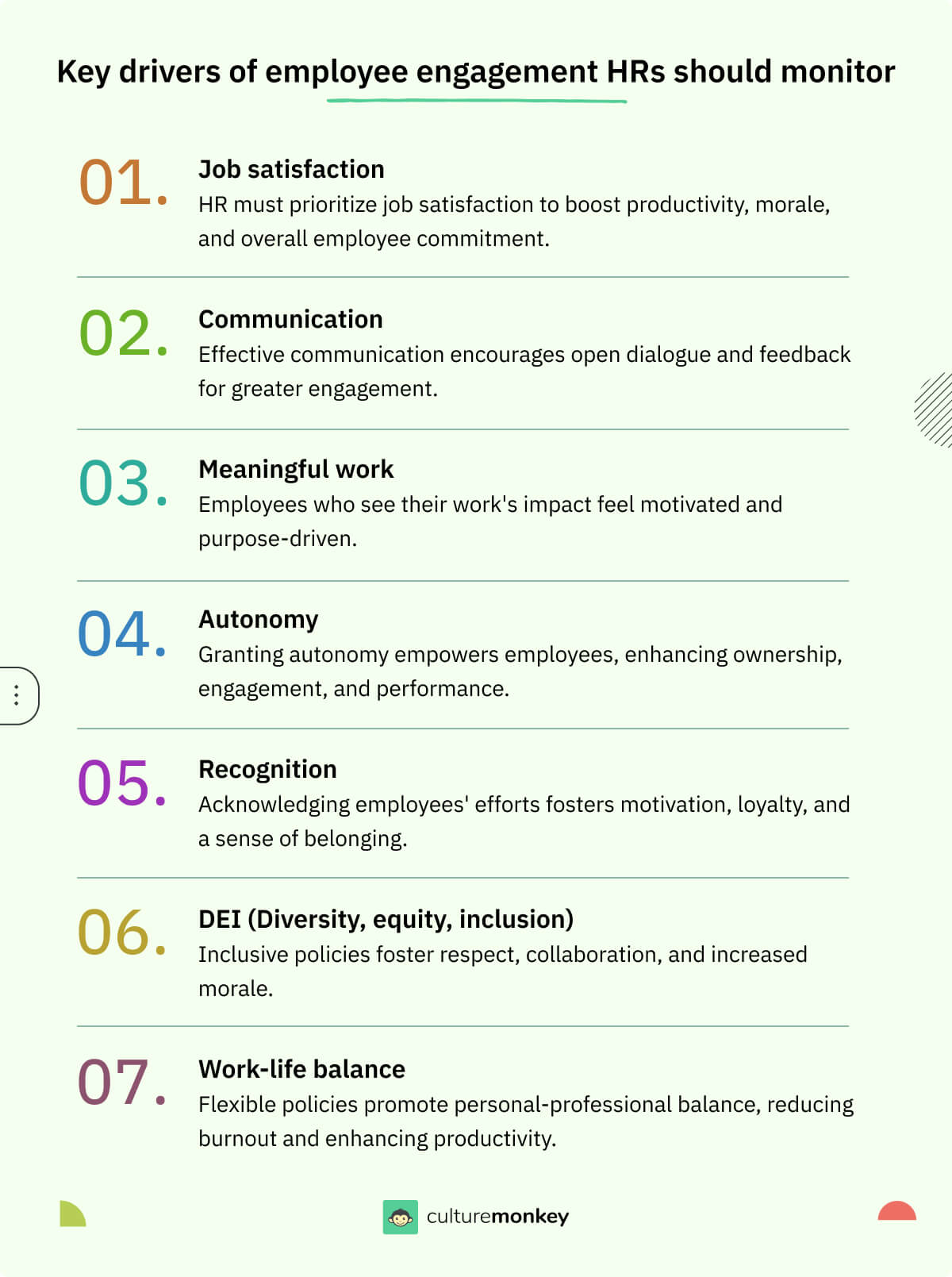
By closely monitoring the key drivers of workplace engagement, the HR department can identify potential problems and take proactive steps to address them. The following are the primary employee engagement key drivers that should be monitored throughout the employee life cycle, highlighting the HR role in employee engagement and its influence on human resources engagement:
- Job satisfaction: Central to employee engagement in human resource management, satisfaction boosts productivity and morale. HR must ensure evolving employee engagement HR policies protect well-being and reflect the organization's culture.
- Communication: Effective communication is one of the different areas of HR that supports internal engagement and trust. HR should maintain open channels that enhance colleague engagement and transparency.
- Meaningful work: Connecting roles to purpose strengthens job engagement and reinforces what is employee engagement in HR. HR must align roles with impactful goals to boost motivation.
- Autonomy: Empowering autonomy encourages innovation and emotional investment, core to hr engagement and employee engagement in HRM strategies.
- Recognition: Regular acknowledgment supports people engagement, promotes staff engagement definition principles, and strengthens HR employee engagement efforts.
- Professional development opportunities: Investing in learning fosters retention and supports human resources and employee engagement by building future-ready talent.
- Collaborative company culture: Encouraging teamwork across teams enhances employee engagement HR and strengthens human resources employee engagement outcomes.
- DEI (Diversity, equity, inclusion): Inclusive environments enrich HR and employee engagement strategies, helping every voice contribute fully.
- Work-life balance: A critical factor in how HR can improve employee engagement, flexible policies promote satisfaction and productivity.
- Workplace culture: Cultivating a positive environment is fundamental to employee engagement in HR and successful employee engagement in human resource management.
- Manager-employee relationship: Strong relationships between managers and employees are vital for employee engagement in HRM. HR should train managers to provide regular feedback, emotional support, and development guidance. Positive relationships enhance colleague engagement, boost morale, and reinforce job engagement across teams.
- Psychological safety: Creating a space where employees feel safe to express ideas, take risks, and share concerns without fear of negative consequences is essential. It supports internal engagement, fosters innovation, and strengthens trust—a key focus in employee engagement HR policies and human resources and employee engagement frameworks.
- Alignment with organizational values: Employees who connect with company values are more motivated and committed. HR must continuously communicate the mission and integrate it into recognition, hiring, and employee engagement in human resource management practices to drive people engagement and loyalty.
How does employee engagement differ from job satisfaction?

Employee engagement and job satisfaction are related but distinct concepts in organizational settings, each with unique implications for employee experience and organizational success.
| Aspect | Employee engagement | Job satisfaction |
|---|---|---|
| Definition | Emotional commitment to the organization, work, and goals. Drives active contribution and initiative. | Contentment with job role, influenced by salary, work conditions, and benefits. |
| Level of effort | Employees actively seek ways to improve, often going above basic job requirements. | Employees perform job roles as expected, with little drive to exceed expectations. |
| Organizational impact | Leads to higher productivity, lower turnover, and increased customer satisfaction. | Primarily affects employee retention and morale but has limited impact on innovation. |
| Sustainability | Can fluctuate with leadership, culture, and organizational support but sustained by values and recognition. | Typically stable, influenced by tangible aspects like pay and benefits. |
| Key drivers | Driven by meaningful work, purpose, empowerment, and personal growth opportunities. | Driven by supportive environment, fair compensation, work-life balance. |
Training HR to effectively implement employee engagement
HR professionals must continuously enhance their skills to better serve their organizations. This ensures they understand workforce needs, create effective talent strategies, and foster a culture of trust. Here are key ways HR can implement engagement and maintain positive workplace culture:
- Take specialized courses and training programs: Specialized courses keep HR professionals updated on industry trends and best practices, enhancing their role in fostering engagement and nurturing company culture. These programs offer insights into recruitment, employee relations, and workplace culture strategies. New skills gained help create positive work environments and strengthen HR capabilities.
- Participate in industry-specific conferences and seminars: Conferences provide HR professionals with essential insights, connections, and strategies to drive employee engagement. Networking opportunities with peers and industry leaders foster idea exchange and mentorship. Attending these events allows HRs to implement fresh engagement measures and improve workplace relations.
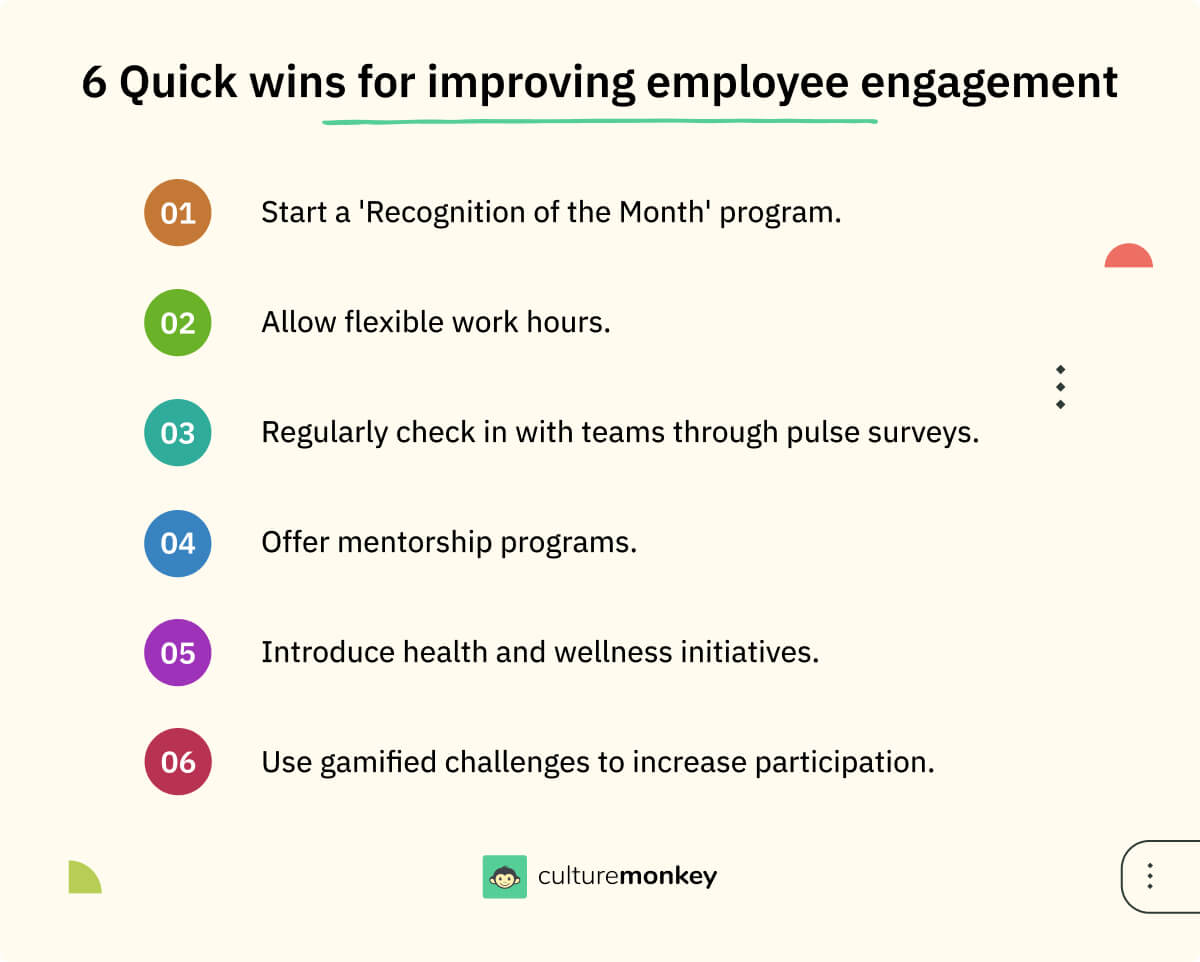
- Attend HR-specific webinars and online courses: Webinars offer flexible learning on the latest HR trends, equipping professionals with updated strategies for building engagement and trust. HR leaders can apply new techniques to foster cultural change, inspire involvement, and enhance their credibility. Staying informed shapes workplace innovation.
- Read books, articles, and other resources related to HR: Consistent reading deepens HR knowledge on engagement strategies, legal compliance, and cultural initiatives. Gaining fresh perspectives through HR literature allows HRs to craft positive work environments. Understanding legal frameworks ensures adherence to standards and informed policy implementation.
- Network with experienced HR professionals: Networking enables HRs to learn from seasoned professionals, leveraging their insights to drive engagement initiatives. Building industry connections offers mentorship, innovative practices, and resource access. Platforms like LinkedIn provide invaluable opportunities to exchange ideas and foster engagement strategies.
- HR technology to attain robust employee engagement: HR software streamlines record management, communication, and employee tracking. Tools like surveys and recognition programs foster engagement and boost morale. Leveraging tech improves workplace culture by identifying gaps and creating effective training or engagement strategies.
Key performance indicators for engagement programs

Measuring the success of employee engagement initiatives requires identifying and tracking key performance indicators (KPIs). Effective engagement programs rely on recognizing metrics that reflect employee engagement in human resource management and organizational impact. These KPIs also illustrate the HR role in employee engagement and the success of HR initiatives for employee engagement.
- Participation rates in engagement activities: These reflect hr engagement by showing involvement in events, a core aspect of people engagement and employee engagement HR policies.
- Employee net promoter score (eNPS): eNPS provides insight into satisfaction and loyalty—key markers in employee engagement in HRM and human resources engagement.
- Internal mobility rate: This measures internal engagement and job engagement, showing how engaged employees are with growth pathways supported by human resources and employee engagement programs.
- Quality of feedback given: Thoughtful feedback demonstrates trust and strong colleague engagement, central to hr employee engagement strategies.
- Response time for employee queries: Fast responses reinforce human resources employee engagement and reflect the efficiency of different areas of HR in action.
- Collaboration metrics: Cross-functional teamwork shows high employee engagement HR and reflects a healthy organizational culture driven by staff engagement definition.
- Rate of suggestions implemented: This signals how well HR and employee engagement efforts listen to and value input, essential in how HR can improve employee engagement and define what is employee engagement in HR.
How can tech help improve employee engagement?
Technology has become an integral part of the modern workplace and can be used as an effective tool to improve workplace engagement. Here are some ways that tech can help improve engagement.
- Tech can be used to create a more efficient and productive work environment. By implementing the right technology tools, businesses can streamline processes and reduce wasted time on mundane tasks.
- Tech helps to facilitate better communication between employees and management. In addition, tools such as project management softwares can help keep everyone on the same page and ensure everyone is working towards the same goals.
- Tech can help to keep employees motivated and engaged. This can be done through gamification, which uses game-like elements to encourage people to complete tasks, leading to a sense of belongingness among employees.
- Technology helps to provide employees with feedback and recognition, which can be done through tools such as employee engagement survey platforms, allowing managers to give employees feedback and rewards for their hard work.
- Technology enables employees to work remotely or adopt flexible schedules through virtual communication tools, cloud-based applications, and remote collaboration platforms. This flexibility can lead to increased satisfaction, work-life balance, and engagement.
- E-learning platforms and digital training tools offer customized learning paths, helping employees grow their skills. Continuous learning opportunities keep employees engaged, motivated, and aligned with organizational goals.
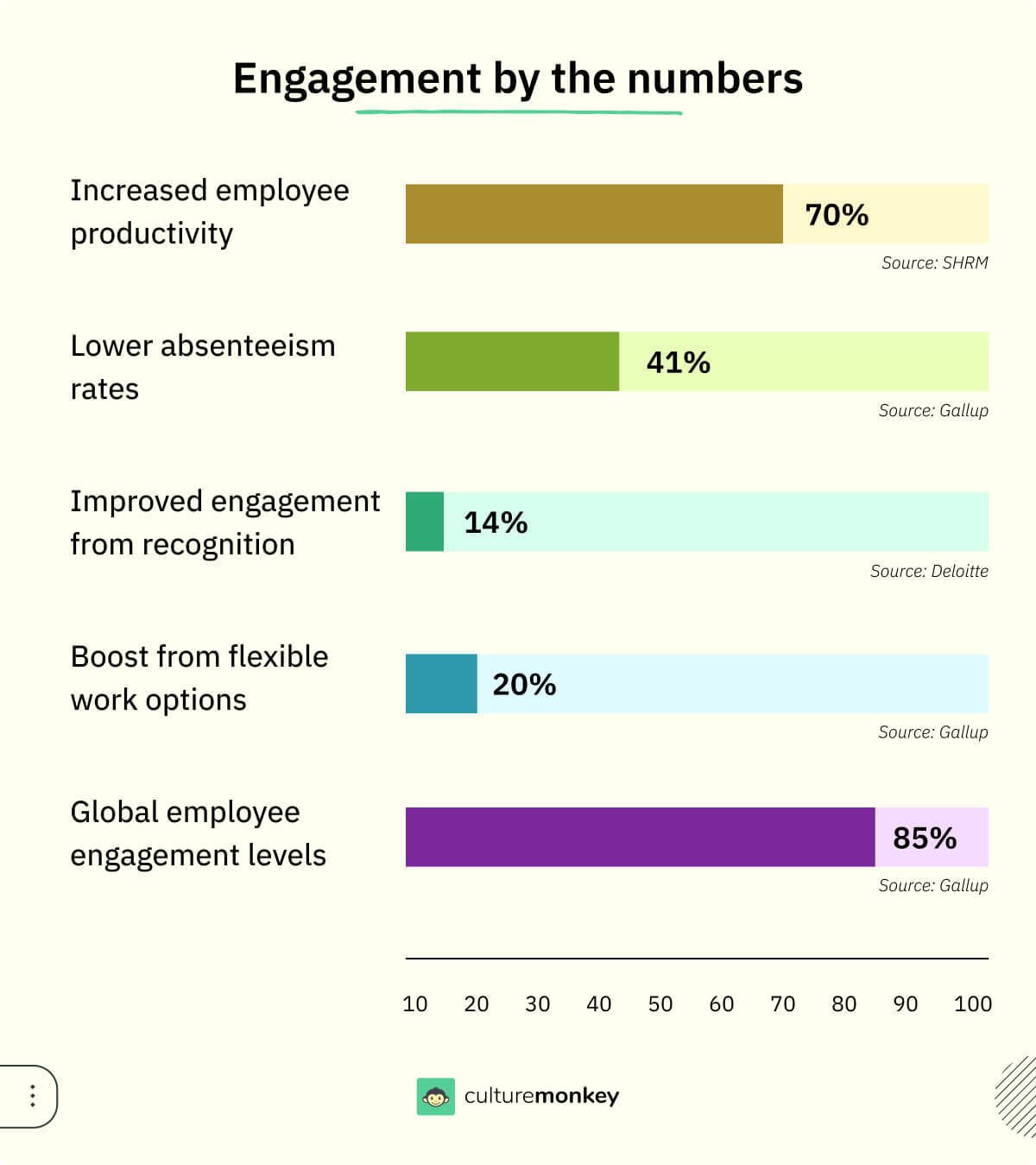
How should HR focus on employee engagement from onboarding?

Creating a positive onboarding experience is crucial for boosting employee engagement and commitment. HR professionals play a key role in ensuring new hires feel welcomed, motivated, and prepared for success.
- Start engagement from day one: A positive employee experience begins when a candidate transitions into an employee. HR professionals should prioritize a structured and engaging onboarding process to foster motivation and commitment right from the start.
- Create an engaging and informative onboarding process: Develop a comprehensive orientation program that introduces new employees to their roles and responsibilities. This should include detailed training on the company’s values, culture, organizational structure, and team dynamics.
- Provide tools and resources for success: Ensure that new hires have access to essential tools and resources such as laptops, software programs, and any necessary equipment to perform their duties efficiently.
- Offer mentorship programs: Pair new employees with mentors who can guide and support them, helping to build a sense of belonging and providing valuable insights into the company culture and workflow.
- Regular feedback and check-ins: Schedule frequent feedback sessions to address concerns, track progress, and keep new hires engaged by showing that their contributions are valued.
- Encourage participation in team-building activities: Foster engagement by providing opportunities for new employees to connect with colleagues through team-building activities, which helps to strengthen workplace relationships and build a sense of camaraderie.
Challenges HRs face in employee engagement practices
Employee engagement is crucial for a company's growth, but unfortunately, there are several challenges that HR professionals face when it comes to planning and executing workplace engagement practices in corporate environments. Here are some primary challenges faced by HRs while implementing employee engagement practices in the workplace:
- Finding the right balance between cost, time, and resources: Workplace engagement activities can be expensive, and HRs must be mindful of their organizations' financial constraints when planning and implementing them.
- Identifying and addressing the needs of all employees: Every employee is different and will have different needs regarding engagement activities. HRs must be able to identify and address these needs to ensure that all employees are involved and engaged.
- Maintaining employee engagement over time: It is one thing to plan and implement an engaging activity but another to sustain it over time. HRs must be able to develop activities that can be sustained and evolve to motivate employees.
- Ensuring that activities are aligned with company goals: It is crucial to ensure that activities are aligned with company goals and objectives to ensure that they are meaningful and effective. HRs must be able to develop activities tailored to the organization's objectives to succeed.
- Encouraging leadership buy-in: HR professionals often face challenges in securing support and active participation from leadership. Effective engagement requires leaders to champion initiatives, set examples, and drive cultural change, which can be difficult if they are disengaged or lack commitment.
- Measuring the impact of engagement initiatives: Demonstrating the ROI of engagement activities can be challenging. HR must track metrics, analyze data, and present evidence that initiatives are enhancing productivity, satisfaction, and retention, often requiring sophisticated tools and analytical skills.
Best HR practices for employee engagement

Effective employee engagement relies on best HR practices that foster a supportive, collaborative, and growth-oriented work environment. Here are key HR strategies to enhance engagement across all organizational levels:
- Customized onboarding programs: Tailoring onboarding to meet individual needs ensures new hires feel connected, valued, and aligned with company culture from the start, setting a strong engagement foundation.
- Regular one-on-one check-ins: Conducting consistent, meaningful one-on-one meetings between managers and employees provides an opportunity to discuss goals, feedback, and personal concerns, building trust and driving engagement.
- Skill development and learning pathways: Offering diverse training, upskilling programs, and career progression paths demonstrates commitment to employee growth and encourages active engagement in their professional journey.
- Peer recognition initiatives: Enabling employees to recognize each other’s contributions fosters a collaborative environment and boosts morale by highlighting accomplishments beyond traditional top-down recognition.
- Flexible work options: Providing remote work capabilities, flexible hours, or hybrid schedules helps employees balance their professional and personal lives, leading to increased engagement and loyalty.
- Action on employee feedback: Establishing a clear feedback loop where employee suggestions are heard, acknowledged, and often implemented validates employee voice and promotes continuous improvement.
- Inclusive work culture: Fostering a diverse and inclusive environment where all employees feel seen, heard, and respected supports engagement by creating a strong sense of belonging.
- Health and wellness programs: Prioritizing physical and mental wellness through initiatives like stress management workshops, fitness classes, and counseling services helps employees stay engaged and productive.

Your guide to
better engagement.
A step-by-step checklist to implement engagement strategies that inspire, motivate, and drive results.
HRs’ approach to engaging Gen Z and other generations
HR professionals must tailor their approach to employee engagement practices to accommodate the diverse needs and expectations of different generations, including Gen Z, millennials, Gen X, and baby boomers. Each generation’s unique preferences, motivations, and values should shape engagement strategies for maximum effectiveness.
Gen Z
- Leverage technology: Integrate digital tools, gamification, and tech-driven engagement platforms to meet their preference for seamless digital experiences.
- Transparency and feedback: Provide frequent and transparent feedback to maintain engagement and build trust, reflecting their desire for open communication.
- Social impact initiatives: Offer opportunities to engage in socially responsible projects, as Gen Z values purpose-driven work and social change.
Millennials
- Career growth: Focus on mentorship, professional development, and clear career pathways to meet their ambition and drive for growth.
- Flexibility and balance: Provide options for flexible schedules and remote work, supporting their emphasis on work-life balance.
- Collaboration culture: Encourage collaboration and innovation through team-oriented projects, reflecting their preference for cooperative work environments.
Gen X
- Work-life balance: Offer flexible work arrangements and policies that cater to their family and personal commitments.
- Skill utilization: Create opportunities that leverage their extensive experience while supporting continued professional development.
- Open communication: Encourage transparent communication and provide platforms for sharing feedback and concerns.
Baby boomers
- Recognition and respect: Acknowledge their experience, contributions, and institutional knowledge through regular recognition and meaningful roles.
- Stability and security: Offer stability-focused benefits and structured career plans to appeal to their needs.
- Knowledge transfer: Involve them in mentorship programs to share their expertise with younger generations, fostering collaboration and respect.
Wellness activities that HR can initiate for different generations

Workplace wellness activities are becoming increasingly popular as employers look to promote a healthier lifestyle among their employees. With four generations in the workforce – Gen Zers, Millennials, Gen Xers, and Baby Boomers – it's important to tailor wellness activities to meet the needs of each generation.
Here are some of the top wellness activities the human resources department can initiate for each generation to help them live healthier and happier lives.
Gen Zers
Gen Zers born after 1996 are often described as the "always-on" generation, which means they're always connected to technology and are used to instant gratification. For this reason, HR should create wellness activities that align with their fast-paced lifestyle—for example, offering short yoga sessions or HIIT classes during lunch hours. This way, Gen Zers can stay active and connected to their devices.
Millennials
Millennials born between 1981 and 1996 are often described as the "me" generation. This means they're used to having many choices and often looking for new experiences. HR should create wellness activities that cater to this need for variety and exploration—for example, offering outdoor activities such as hiking or kayaking. This way, Millennials can stay active and explore their surroundings while having a sense of adventure.
Gen Xers
Gen Xers born between 1965 and 1980 are often seen as the bridge between the Baby Boomer and Millennial generations. They're independent, self-reliant, and driven. HR should create wellness activities emphasizing these traits, such as offering meditation sessions to promote mental clarity and focus. This will help Gen Xers stay productive and motivated while also taking time to relax and recharge.
Baby Boomers
Baby Boomers born between 1946 and 1964 are often seen as the "work hard, play hard" generation. This means they're used to having a lot of responsibility and are driven to succeed. HR should create wellness activities such as health education seminars or workshops emphasizing these traits. This will help Baby Boomers stay informed and motivated while also taking time to relax and care for their health.

Team engagement
made easy
Discover actionable team activities inspired by survey insights to boost engagement, collaboration, and morale.
HR’s role in employee engagement
Human Resources (HR) plays a pivotal role in fostering and sustaining employee engagement within an organization. By aligning organizational goals with employee needs and fostering a positive work environment, HR ensures that engagement becomes a strategic priority. Key responsibilities include:
- Creating an engaging work culture: HR establishes core values and promotes a culture that aligns with employees’ expectations. By encouraging a respectful, inclusive, and collaborative environment, HR nurtures a sense of belonging.
- Designing targeted engagement programs: HR leads the development and execution of programs tailored to boost engagement, including wellness initiatives, training sessions, mentorship schemes, and team-building activities.
- Facilitating transparent communication: HR acts as a bridge between employees and leadership, ensuring open lines of communication. Town hall meetings, regular updates, and employee forums allow employees to voice their ideas and concerns.
- Offering career development: HR ensures access to meaningful career paths, coaching, and skill-building opportunities that align with both organizational goals and employee aspirations, enhancing long-term engagement.
- Regularly measuring engagement: Utilizing surveys, feedback tools, and performance metrics, HR assesses engagement levels and identifies areas for improvement. This data-driven approach enables strategic adjustments.
- Recognizing and rewarding efforts: HR leads recognition initiatives, celebrating both individual and team achievements to drive motivation, satisfaction, and retention.
- Building leadership capabilities: By training managers to lead with empathy and effective communication, HR helps create leaders who inspire and engage their teams, fostering a culture of commitment and excellence.
Measuring and tracking engaged employees for results

Effectively measuring and tracking employee engagement is essential for HR professionals aiming to maximize workforce productivity and satisfaction. By employing specific tools and metrics, HR can gain insights into engagement levels and make strategic improvements. Here are key methods for tracking and measuring engagement:
- Pulse surveys: Conducting frequent, brief surveys allows HR to gauge real-time engagement trends, uncovering concerns, and tracking the impact of initiatives.
- Behavioral analytics: Tracking employee behaviors, such as participation in team activities, project involvement, or collaboration tools, offers insights into engagement levels and areas needing attention.
- Retention and turnover rates: High engagement often correlates with lower turnover. By monitoring retention patterns, HR can assess whether engagement efforts are improving employee loyalty.
- Feedback quality and frequency: Analyzing the quality and volume of feedback received from employees provides a gauge for their connection to work and willingness to communicate.
- Performance metrics: Tracking changes in productivity, efficiency, and goal attainment can indicate whether engagement initiatives are positively impacting performance.
- Recognition program participation: Monitoring the extent to which employees engage with recognition and reward programs can reflect their overall morale and satisfaction.
Conclusion
Anonymous survey data from pulse and employee engagement surveys helps HR roles design targeted initiatives to improve eNPS, morale, and productivity. In today’s evolving work landscape, understanding employee engagement in human resource management is key to fostering a thriving, people-first culture.
Employee engagement surveys are essential HR initiatives for employee engagement, offering real-time insights that drive internal engagement, colleague engagement, and alignment across different areas of HR. These tools empower HR professionals to adapt strategies that support hybrid and remote teams, boost job engagement, and promote a cohesive employee experience.
CultureMonkey’s employee engagement survey tool enables organizations to build positive, engaging work environments. With tailored, actionable insights, it supports human resources engagement and helps leaders enhance workspace engagement across locations. CultureMonkey equips HR with the feedback needed to keep employees connected, valued, and aligned with modern work practices.
Summary
Employee engagement surveys help HR gauge workforce satisfaction, commitment, and alignment with organizational values. The surveys explore areas like communication, job satisfaction, leadership impact, and professional growth opportunities. Analyzing responses allows HR to pinpoint strengths, uncover gaps, and tailor initiatives to drive engagement.
Conducting regular surveys fosters transparency, builds trust, and underscores a culture of continuous improvement, leading to higher retention, productivity, and overall morale. This approach ensures that organizations remain adaptable to changing employee needs and priorities.
FAQs
1. How frequently should employee engagement be measured?
Employee engagement should be measured on an ongoing basis, combining annual surveys, quarterly assessments, and frequent pulse checks. This multi-tiered approach ensures HR can capture both long-term trends and immediate feedback, allowing for timely adjustments and improvements. Popular employee engagement survey vendors help you with regular measurement and help you demonstrate commitment to employees' needs.
2. How does employee engagement relate to employee retention?
Employee engagement is closely tied to retention as engaged employees are more invested in their roles and the organization's success. High engagement fosters job satisfaction, loyalty, and motivation, reducing turnover rates. When employees feel valued, supported, and connected to their work, they are less likely to seek opportunities elsewhere. This lowers recruitment costs and maintains a stable, experienced workforce aligned with organizational goals.
3. How can HR use feedback to enhance employee engagement?
HR can collect employee feedback through surveys, suggestion boxes, and regular meetings to identify engagement barriers and areas for improvement. By actively addressing employee input, HR can implement changes that enhance job satisfaction, work culture, and overall engagement. Transparent follow-ups on feedback show employees they are heard and valued, creating a positive feedback loop that boosts trust, collaboration, and motivation.
4. How does work-life balance influence employee engagement?
A balanced work-life dynamic prevents burnout and improves employee well-being, leading to higher engagement and productivity. When employees can manage work and personal responsibilities effectively, they feel more valued and supported by their organization. HR initiatives ideas for employees that encourage flexibility, such as remote work options and flexible hours, directly enhance engagement by promoting employee satisfaction, reducing stress, and fostering loyalty.
5. How can HR promote a culture of autonomy to boost engagement?
HR can foster a culture of autonomy by empowering employees to make decisions, manage projects independently, and offer flexible work arrangements. Encouraging employees to take ownership of their roles builds trust and demonstrates respect for their expertise. Autonomy drives motivation, creativity, and job satisfaction, leading to higher engagement levels. Balanced support and accountability ensure autonomy aligns with organizational goals and success.
6. How does HR measure employee engagement?
HR measures employee engagement through surveys (e.g., eNPS, pulse, and annual engagement surveys), participation rates in initiatives, feedback quality, turnover and retention metrics, and productivity levels. They also analyze collaboration patterns, internal mobility, and absenteeism to gauge engagement across departments. These insights help HR evaluate the effectiveness of engagement strategies and identify improvement areas.
7. How can HR use data to boost employee engagement?
HR uses engagement data to uncover trends, identify pain points, and tailor interventions that align with employee needs. By analyzing survey feedback, performance data, and behavioral patterns, HR can personalize initiatives, improve communication, and enhance recognition programs. Data also enables proactive action, helping HR fine-tune strategies, increase satisfaction, and promote a culture of continuous human resources engagement.
8. How can HR support managers in fostering employee engagement?
HR supports managers by providing training, resources, and data insights to help them understand team dynamics and address engagement gaps. They equip managers with tools like engagement dashboards, recognition platforms, and feedback frameworks. HR also encourages regular check-ins, coaching, and development opportunities to strengthen manager-employee relationships and foster a positive, high-engagement team culture.
9. Can employee engagement initiatives backfire if done poorly?
Yes, employee engagement initiatives can backfire if they feel forced, superficial, or insincere. Employees may perceive such efforts as mere box-ticking or manipulation, leading to mistrust and disengagement. Poorly executed programs that lack follow-through or ignore real feedback can damage morale. Authenticity, clear communication, and meaningful action based on employee input are essential for engagement initiatives to succeed.
10. Does employee engagement in HR affect employer branding?
Yes, employee engagement in HR directly impacts employer branding by shaping how employees perceive and talk about the company. Engaged employees are more likely to share positive experiences, recommend the organization to others, and represent the company as a great place to work, which attracts top talent and enhances the company’s reputation in the job market.




